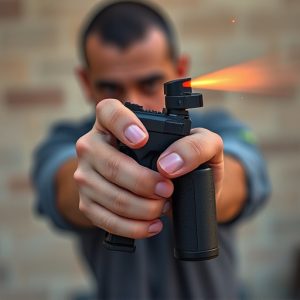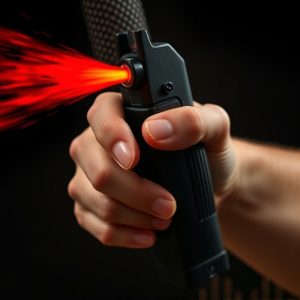Riot Control Canisters: Composition, Deployment Strategies, and Future Trends
Riot control spray canisters, using capsaicin from chili peppers, are non-lethal weapons for crowd m…….
Riot control spray canisters, using capsaicin from chili peppers, are non-lethal weapons for crowd management. The Spray and Move strategy involves advanced deployment techniques like aiming at the ground, sweeping motions, and quick movement to maximize coverage while minimizing harm. This method is crucial in civil unrest, de-escalating violence, and ensuring swift crowd control. Effective use requires specialized training, understanding of spray range and wind impact, and prioritizing safety with proper equipment and medical evaluations. Future riot control focuses on targeted aerosolization and water-based alternatives, reflecting a trend towards more humane and strategic methods.
Riot control inflammatory spray canisters have long been a cornerstone of law enforcement strategies, but their effective and safe deployment remains a critical topic. This article delves into the intricate details of these powerful tools, exploring their composition, deployment techniques like the Spray and Move strategy, and ideal use cases. We discuss safety considerations essential for officer training and look ahead to emerging trends in riot control technology. By understanding these aspects, law enforcement can ensure responsible and effective crowd management.
- Understanding Riot Control Spray Canisters: Their Composition and Effects
- Spray and Move Deployment Strategy: Step-by-Step Guide
- Effective Use Cases: When to Deploy Riot Control Spray
- Safety Considerations and Training for Law Enforcement Officers
- Future Trends in Riot Control Technology: Beyond the Traditional Spray
Understanding Riot Control Spray Canisters: Their Composition and Effects
Riot control spray canisters, also known as pepper spray or CS gas canisters, are non-lethal weapons designed for law enforcement and military purposes during crowd control situations. These canisters contain a potent chemical agent that, when deployed, creates an immediate impact area to disable or disrupt rioters and protesters, allowing authorities to regain control of chaotic scenarios. The composition of these sprays typically includes capsaicin, a compound derived from chili peppers, which irritates the eyes, nose, and respiratory system, causing temporary blindness and difficulty breathing.
The deployment techniques for riot control spray involve strategic and calculated movements. Officers or military personnel are trained to use specific Spray and Move tactics, ensuring the agent is effectively distributed while minimizing off-target effects. This often includes aiming towards the ground, spraying in a sweeping motion, and then quickly moving through the affected area. These techniques have evolved over time, with advanced spray patterns designed to maximize coverage and reduce the risk of harm to bystanders or individuals with respiratory conditions.
Spray and Move Deployment Strategy: Step-by-Step Guide
The Spray and Move Deployment Strategy is a tactic used by law enforcement and riot control teams to effectively manage and disperse crowds during protests or disturbances. This method involves the strategic use of inflammatory spray canisters, combined with swift tactical movement, to disrupt and control crowd behavior.
Here’s a step-by-step guide:
1. Assess the Situation: Before deployment, officers must quickly assess the crowd’s composition, size, and potential for violence. This includes identifying leaders or ringleaders who could escalate tensions.
2. Positioning: Officers form a line, positioning themselves at a safe distance from the crowd yet close enough to make a swift impact. The formation should allow for easy movement and quick re-positioning.
3. Visual and Verbal Warning: A clear, loud verbal warning is issued, instructing the crowd to disperse or face the use of force. Visual aids, such as raising canisters or using bright lights, can further emphasize the threat.
4. Spray Deployment: Upon receiving no compliance from the crowd, officers simultaneously deploy the spray canisters, aiming for the legs and lower torso of individuals in the front rows. This disrupts balance and reduces mobility without causing severe harm.
5. Tactical Movement: As the crowd begins to scatter, officers swiftly move forward, clearing the area while maintaining a safe distance. They continue to use canisters on any individuals who resist or attempt to regroup, ensuring the rapid dissipation of the crowd.
Effective Use Cases: When to Deploy Riot Control Spray
Riot control inflammatory spray canisters are powerful tools used by law enforcement and security personnel for crowd control in various high-risk situations. The effective use cases for deploying these canisters involve scenarios where non-lethal force is required to disrupt and disperse violent or unruly crowds, making it an essential addition to riot gear.
When considering spray and move deployment techniques, timing and distance are crucial. Officers aim to create a barrier between the crowd and their objectives while minimizing the impact on bystanders. This tactic is particularly useful in situations like civil unrest, protests turning violent, or when dealing with aggressive individuals who pose a threat to public safety. The spray’s ability to cause temporary blindness and irritation allows for a swift retreat of the crowd, providing an opportunity to de-escalate tensions and facilitate better control over the situation.
Safety Considerations and Training for Law Enforcement Officers
Law enforcement officers using riot control inflammatory spray must prioritize safety above all else. Proper training in spray and move deployment techniques is crucial to minimize risks for both the officers and the community. This includes understanding the can’s range, wind conditions, and the need to target specific individuals or areas rather than indiscriminately spraying.
Officers should be schooled in de-escalation strategies, allowing them to resolve situations peacefully before resorting to chemical agents. Regular practice sessions with simulated scenarios help officers hone their skills, ensuring they use the spray responsibly and effectively only when necessary. Adequate personal protective equipment and regular medical evaluations for officers are also vital components of a comprehensive safety program.
Future Trends in Riot Control Technology: Beyond the Traditional Spray
The future of riot control is looking beyond the traditional spray canisters, with a growing focus on innovative and strategic deployment techniques. One emerging trend is the development of advanced spraying systems that utilize precise aerosolization, allowing for more targeted and controlled applications. These technologies aim to minimize off-target effects and reduce harm to bystanders, a significant concern in modern policing strategies.
Additionally, there’s a surge in research towards non-lethal, water-based alternatives that still disrupt and disperse crowds effectively. These products often incorporate advanced ingredients and delivery mechanisms, such as Spray and Move deployment techniques, enabling rapid de-escalation without resorting to harmful chemicals. Such developments reflect a broader industry shift toward more humane and strategic riot control methods, keeping pace with evolving societal needs and legal standards.
Riot control inflammatory spray canisters, while powerful tools, require careful consideration and responsible deployment. Understanding their composition, effects, and proper usage is key to ensuring public safety during civil disturbances. The Spray and Move Deployment Techniques, when combined with adequate training, allow law enforcement officers to manage crowds effectively. As technology advances, future trends in riot control aim to enhance safety and minimize impact on non-target areas, reflecting a continuous evolution in crowd control strategies.

